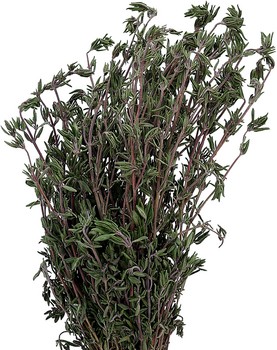How to Grow Thyme
Thyme is a common plant that’s grown both indoors and outdoors. Many people learn how to grow thyme as one of their first gardening projects. In case you’re a new gardener or florist and were wondering, thyme is classified as an herb.
Learning how to grow thyme is a rewarding way for beginning agriculturalists and plant enthusiasts to start their new hobby, since you can use the herb in your meals and the gardening isn’t too intensive.
Growing your own thyme is handy, since plants and vegetables you grow yourself are much more likely to be fresher and of higher quality than store bought analogs. Thyme is also useful as a gift for friends and relatives who appreciate the time and effort that went into the production of the plant, as well as the thought you gave of them.
Thyme Information and Preparation
Thyme is a popular herb, known for its strong taste affectations when applied to many foods and recipes. Thyme is most popular in Arab dishes and varies in its actual usage. Some dishes may use fresh pieces of thyme, while others require the dried leaves, discarding the stem and buds.
Thyme is known to have medicinal qualities, too, usually in the form of thyme oil. This oil has antiseptic properties and is used in products such as mouthwash. Thyme tea is prescribed as a home herbal remedy for bronchitis, though it’s suggested that a serious or chronic illness be treated by a medical professional, in addition to any natural practices you may prefer.
Preparing to Grow Thyme
You need to gather several items in preparation for your thyme growing experience. First off, you need typical gardening tools, like a watering can and spade. This may change depending on your context.
Keep in mind that thyme may not grow well in your climate, or that you may want to begin your thyme project during an off-season. Growing inside your home with potted plants is an option that eliminates the need for the spade. In this case, you need soil, pots and containers, seeds or existing thyme plants, aw well as soil enrichment materials.
Growing Thyme

How to Grow Thyme
You can either start your growing thyme project with thyme seeds or existing thyme plants. With the latter option, you only use part of the plant in question.
When planting thyme you have the option of using part of a thyme plant, which produces more consistent and fruitful plants, though seeds have the advantage of being cheaper and easier to purchase than an entire plant.
You want plenty of organic matter in the soil that you use as a base for your thyme project, whether it’s an your outdoor personal garden or planted in a pot or container indoors. Mix in almost equal parts of soil with soil-enhancement or fertilizer. Allow your plants to get plenty of sunlight, so account for this in your placement. This is a consideration when deciding where to plant in your garden bed, or where you set the pot that contains your seeds or buds.
The soil should be on the dry side, if possible, so constructing your soil base mix and letting it sit and air out is a good idea, before you start planting thyme seeds or plant parts. After you’ve prepared the soil bed, plant each thyme about 6 to 12 inches apart, depending on your space allowance and container size.
Bury each plant about 4 to 5 inches under the soil and cover with your spade. Allow the plants to grow for 3 to 4 weeks, before you expect significant results. Watering schedules for thyme can be moderate to low.
Allow the soil to dry up almost completely before re-watering.
Pruning Thyme Plants
Prune the plants significantly as they flower. This promotes bushy plant growth and a larger yield of thyme crop. Thyme is also a perennial plant, so dividing up the plants every three or four years keeps individual plants dense and healthy.
Keep in mind that the more of the plant you cut off, the more it will promote growth. If you go through a time where your thyme demand increases, don’t fret. Even if you shear off all of your budded flowers, they quickly grow back and in greater density and numbers than ever before.
As you learn how to grow thyme, experiment with your pruning practices, so you learn the right amount of pruning for optimal thyme production.
